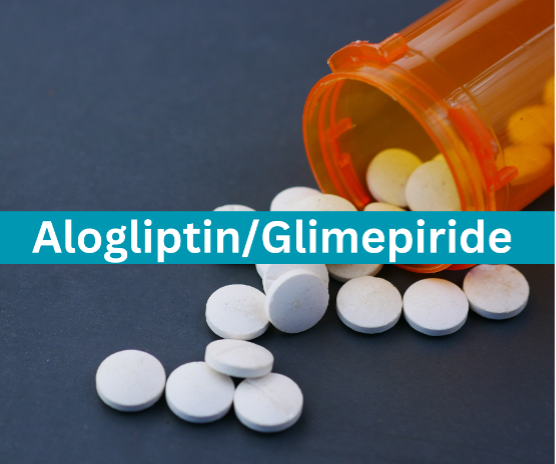Za Pharmacy
Drugs, Supplies and Delivery
Alogliptin/Glimepiride Tablets
Alogliptin/glimepiride is a fixed-dose combination oral antidiabetic medication used to manage type 2 diabetes mellitus. This article examines its pharmacology, clinical applications, and safety profile, drawing on the British National Formulary (BNF), Lippincott Textbook of Pharmacology, and Lange Basic & Clinical Pharmacology.
Alogliptin: A dipeptidyl peptidase-4 (DPP-4) inhibitor, alogliptin enhances glucose-dependent insulin secretion by prolonging the activity of incretin hormones (GLP-1 and GIP). These hormones suppress glucagon release, slow gastric emptying, and reduce hepatic glucose production (Lippincott). DPP-4 inhibition increases active incretin levels by 2-3 fold, improving both fasting and postprandial hyperglycemia (BNF).
Glimepiride: A sulfonylurea, glimepiride stimulates insulin secretion from pancreatic β-cells by binding to ATP-sensitive potassium (K⁺ATP) channels, causing cell depolarization and calcium influx. It also enhances peripheral insulin sensitivity (Lange).
Combined Effect: The dual action addresses insulin deficiency (glimepiride) and improves incretin-mediated glucose regulation (alogliptin), offering complementary glycemic control (BNF).
- Primary Indication: Management of type 2 diabetes mellitus in adults inadequately controlled by monotherapy (e.g., metformin) or as an adjunct to diet/exercise when dual therapy is warranted.
- Adjunctive Therapy: May be combined with other agents (e.g., metformin, insulin) under specialist guidance (BNF).
- Available Strengths: Alogliptin (12.5 mg or 25 mg) combined with glimepiride (1 mg, 2 mg, or 4 mg). Common formulations include 12.5/1, 12.5/2, 25/1, and 25/2 mg (BNF).
- Standard Dose: Once daily with the first meal of the day.
- Alogliptin: Adjust for renal impairment (e.g., 12.5 mg daily if eGFR <60 mL/min; avoid if eGFR <30 mL/min).
- Glimepiride: Initiate at 1–2 mg/day, titrated gradually to avoid hypoglycemia (max 8 mg/day).
- Elderly/Hepatic Impairment: Use lower glimepiride doses due to prolonged hypoglycemia risk (Lange).
- Alogliptin: Nasopharyngitis, headache, upper respiratory infections.
- Glimepiride: Hypoglycemia (dose-dependent), weight gain, dizziness.
Serious:
- Glimepiride: Severe hypoglycemia (especially in elderly/renal impairment), hemolytic anemia (rare), hypersensitivity.
- Alogliptin: Acute pancreatitis (rare), angioedema, joint pain (BNF).
- Contraindications:
- Type 1 diabetes, diabetic ketoacidosis, severe renal/hepatic impairment.
- Hypersensitivity to sulfonylureas or DPP-4 inhibitors.
- Blood glucose (to detect hypoglycemia), renal function, HbA1c, and liver enzymes.
- Signs of pancreatitis (e.g., severe abdominal pain, vomiting).
Category C (glimepiride); avoid due to hypoglycemia risk in neonates.
- Glimepiride:
- CYP2C9 Inhibitors (e.g., fluconazole, amiodarone): Increase hypoglycemia risk.
- Beta-blockers: Mask hypoglycemia symptoms.
- Alcohol: Disulfiram-like reaction (rare) or potentiated hypoglycemia.
- Alogliptin:
- CYP3A4 Inducers (e.g., rifampicin): May reduce efficacy.
- General:
- Hypoglycemia risk heightened with insulin, other sulfonylureas, or GLP-1 agonists. Avoid concurrent use with pioglitazone due to additive edema risk (Lippincott).
- Generic: Alogliptin/glimepiride.
Brand Examples: Not widely marketed; available as generics in some regions (e.g., India).

